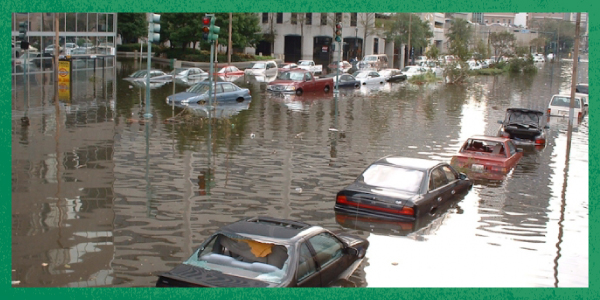
Top 5 Stories Worth Reading — March 2025
Mar 31, 2025
In honor of Black History Month, we are reflecting on how the environmental justice movement came to life and recognizing some of the Black Americans who led and continue to lead this movement. In our first post, we recounted some key moments and trailblazers in the history of environmental justice from 1960 to 1990. In this post, we pick up where we left off in the 1990s through the present day.
The new decade brought with it the evolution and growing impact of the environmental justice movement. In 1990, environmental justice gained recognition as an academic field of study when two faculty members from the University of Michigan – Dr. Bunyan Bryant and Dr. Paul Mohai – organized the Michigan Conference on Race and the Incidence of Environmental Hazards. Drs. Bryant and Mohai also led a diverse team of academics and activists, later named the Michigan Coalition, to meet with the Environmental Protection Agency (EPA) to advise upon environmental justice issues.
The movement found new champions in Black advocates, lobbyists, and elected officials who pushed for the incorporation of environmental justice principles into federal policy. In April 1990, the Congressional Black Caucus met with the EPA to convey the reality of environmental inequities in low-income and communities of color. That July, the Environmental Equity Workgroup was created, which later produced the Reducing Risk for All Communities report with recommendations for addressing environmental injustices.
In 1991, people of African, Latino, Native, and Asian descent convened the First National People of Color Environmental Leadership Summit in Washington, D.C. to unite the movement and encompass the various struggles and empowerment of communities of color. The 1,100 delegates created 17 Principles of Environmental Justice, a document that established guidelines for the movement and defined the environment’s role within the broad framework of well-being, racial, social, and economic justice.
In 1992, President Bill Clinton recruited Dr. Ben Chavis (highlighted in last week’s post) and Dr. Robert Bullard for the administration’s Natural Resources Transition Team. Dr. Bullard, often referred to as the father of the environmental justice movement, was the founding director of the Environmental Justice Resource Center at Clark Atlanta University and is the award-winning author of Dumping in Dixie – the first book focused primarily on documenting environmental injustice in the United States – along with 17 other books that address environmental racism and climate justice.
Thanks to the environmental justice work and involvement of these and other leaders, in 1994, President Clinton signed a landmark Executive Order directing federal agencies to adopt the movement’s standards of improving conditions for low-income communities and communities of color in agency policies and programs.
By the early 2000s, the movement had gained national attention, with a growing number of publications exposing environmental racism and injustice and recognizing the networks, organizations, and resource centers established to combat these challenges. The EPA publicly supported environmental justice and created action plans to help achieve a future where “everyone, regardless of race, culture, or income, enjoys the same degree of protection from environmental and health hazards.” Tragically, this stated support did not bring about the changes needed in time to prevent future disasters.
In August 2005, fueled by climate change and compounded by the failure to maintain critical levees and floodwalls, Hurricane Katrina devastated New Orleans and the surrounding areas and claimed at least 1,833 lives. Predominantly Black Gulf Coast communities had already been facing disproportionate environmental harm for decades, including from 125 oil and petrochemical plants between New Orleans and Baton Rouge, and the storm perpetuated the same pattern. Communities of color were hit hardest by Katrina, especially predominantly-Black neighborhoods that sat below sea level, which made them more vulnerable to damage from hurricanes and floods. Even though studies prior to Katrina had sounded the alarm about the damage likely to result from a hurricane of this size, the government failed to heed these warnings, and after the storm, communities faced insufficient supplies, inadequate provisions for homeless and low-income residents, and evacuation dangerously delayed due to lack of infrastructure. Katrina’s effects in New Orleans, where the majority of residents are Black and many neighborhoods are sinking further below sea level each year, exemplifies the severe and disproportionate impacts of the climate crisis on communities of color in the U.S.

Less than five years after this tragic disaster, environmental justice was finally established as an agency-wide priority of the EPA. The Obama White House also hosted the first Forum on Environmental Justice, attended by more than 100 leaders, Cabinet secretaries and senior officials to give national voice to those impacted by environmental racism and injustice.
However, despite attention by the Obama administration, possibly the worst example of environmental injustice was yet to come. In a 2014 decision by Michigan Governor Rick Snyder, the city of Flint began using the Flint River, polluted with lead and other toxins, as the primary drinking source for the community – a predominantly Black and low-income community. Even as residents began suffering from health issues likely related to lead contamination, their concerns were repeatedly dismissed and ignored by the government. It was not until 2018 that the water was deemed “safe” again, but even today, Flint residents are still reeling from the effects.
Margie Eugene-Richard became the first Black woman to win the Goldman Environmental Prize in 2004 for her successful efforts relocating a community away from toxic chemical plants in Cancer Alley– an area in southern Louisiana along the lower Mississippi River with nearly 150 oil refineries, plastics plants and chemical facilities. Margie Eugene-Richard pushed Shell Chemical to reduce its toxic emissions by 30 percent, contribute $5 million to a community development fund, and finance relocation efforts in Louisiana.
Today, in 2022, progress has been made and some fights have been won, but the environmental justice movement is far from over. Communities of color and low-income communities, especially Black communities, still bear the brunt of the climate crisis and disproportionate harm from pollution and policy decisions — and the leadership, courage, and determination for justice from Black leaders that began in the 1960s still prevail.
At LCV, we are fighting to end environmental racism, center Black, Indigenous, and People of Color’s voices in the climate movement, and prioritize environmental justice for communities in policies at all levels of government. We continue to advocate for swift passage in Congress of the climate and environmental justice provisions in the Build Back Better agenda, including more than $162 billion in investments to advance environmental justice priorities supported by the Equitable and Just National Climate Platform, and the Justice 40 initiative of the Biden-Harris administration will ensure that at least 40% of the total package of $555 billion in investment benefits will flow to disadvantaged and environmental justice communities. We won’t stop fighting alongside leaders across the country to pass policies that support this agenda and honor the long, hard fight of the environmental justice movement.
Image #1:
Image #2:
Cars parked on the streets of New Orleans on Aug. 30, 2005, are flooded to the top of the wheel wells, Photo by Marty Bahamonde, FEMA, Copyright Info